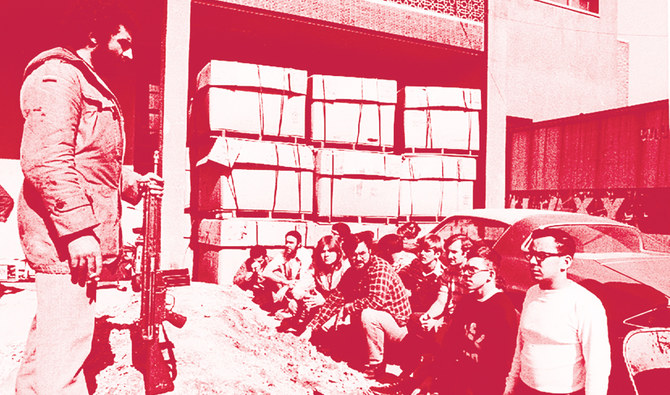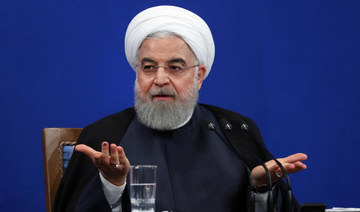DUBAI: Forty years ago, a mob of Iranian students seized the US Embassy in Tehran and took dozens of staff members hostage. On Monday, demonstrators chanting “Down with USA” and “Death to America” gathered in front of the same building as state TV aired videos of rallies in other Iranian cities.
Many of the ugly sentiments from 1979 remain today amid renewed tensions between the two countries, following the unraveling of Iran’s 2015 nuclear deal and the re-imposition of US sanctions on the Iranian economy.
“Thanks to God, today the revolution’s seedlings have evolved into a fruitful and huge tree. Its shadow has covered the entire Middle East,” said Gen. Abdolrahim Mousavi, the commander of the Iranian army, in what was a clear allusion to the “crescent of power” that today stretches from Tehran all the way to the Mediterranean Sea.
There is no denying that 40 years after the Islamic Revolution, Iran’s “shadow” covers large expanses of the Middle East. It has expanded since the 2003 US-led invasion of Iraq. But to those living under Iran’s shadow, the “fruitful and huge tree” stands for a combination of religious fundamentalism, cross-border terrorism, domestic repression and foreign meddling.
Currently, Iraq and Lebanon are witnessing massive anti-government demonstrations. While those protests are fueled by local grievances and mainly directed at political elites, they pose a clear danger to Iran, which backs both governments and powerful militias in each country.
“Although many originally came out over issues of jobs, the cost of living and failing services, the protests evolved into an existential confrontation with the agents of Iran and their malign impact on society,” wrote political commentator Baria Alamuddin for Arab News.
If there is a specific date for the beginning of Iran’s “malign impact,” it is arguably Nov. 4, 1979.
The assault that day on the US Embassy in Tehran was the culmination of protests by supporters of the revolution, demanding the extradition of the shah, Mohammed Reza Pahlavi, who was in the US receiving treatment for cancer.
According to an AP report from the time, “a mob of Iranian students overran US Marine guards in a three-hour struggle Sunday and invaded the American Embassy in Tehran, seizing dozens of staff members as hostages, Tehran Radio reported.” After seven days, the women and African-Americans were freed.
In April 1980, US President Jimmy Carter cut diplomatic ties with Iran, imposed more sanctions and ordered all Iranian diplomats to leave the US. The same month, a failed US mission to rescue the hostages resulted in several deaths, including eight US soldiers.
Finally, on Jan. 20, 1981, after secret negotiations that resulted in the signing of an agreement to free Iranian assets, the remaining 52 Americans were flown to Wiesbaden air base in Germany.
The hostage-taking marked the moment US-Iranian relations began deteriorating sharply.
Opinion
This section contains relevant reference points, placed in (Opinion field)
Under the shah, relations were good as Iran was more or less Washington’s main strategic ally in the region, having a status equivalent to, if not higher than, Israel.
The release of the hostages signaled the end of a traumatic chapter in US diplomatic history, but for Arab countries of the Middle East, it marked the beginning of an era of terrorism, sectarianism and conflicts that continue to this day.
A demonstration on Monday outside the Iranian consulate in Iraq’s holy city of Karbala saw protestors spray-painting “Karbala is free, Iran out!” on walls. Posters of the Iranian Supreme Leader Ayatollah Ali Khamenei have been burnt — the protests have cost the lives of more than 250 people.
In Lebanon, a movement against corruption and the official confessional system has paralyzed the country for three weeks. Along with demands for a non-sectarian government, protesters have aimed anger at Tehran. “Iran wants to close its ears as it has caused poverty, militia dominance in other countries and government failure. The truth is that the accusations match reality,” wrote Arab News columnist Abdul Rahman Al-Rashed on Oct. 31.
In retrospect, the hostage crisis came as a major shock to the West. US intelligence had failed to anticipate it or the revolution. The consequences of that reverberate to this day across the Middle East. Attacking diplomatic posts remains an Iranian tactic. A mob stormed the UK Embassy in Tehran in 2011, while Saudi Arabian diplomatic posts were attacked in 2016.
FORTY YEARS OF ANIMOSITY
1979 - The Shah of Iran, Mohammed Reza Pahlavi, forced to leave country on Jan. 16 after months of protests and strikes.
1979 - US diplomats and citizens taken hostage after Iranian students seize US Embassy on Nov. 4 in Tehran in violation of Vienna Convention, demanding return of the shah to stand trial.
1980 - US cuts diplomatic ties with Iran, seizes Iranian assets and restricts trade with the Islamic Republic. Failed US mission on April 24 to rescue the hostages results in several deaths.
1981 - On Jan. 20, 52 US hostages freed after spending 444 days in captivity as part of a “final complete agreement.”
1984 - Iran listed by the administration of US President Ronald Reagan as a state sponsor of terrorism.
1985-86 - Iran-Contra scandal sheds light on secret deal during Reagan’s presidency to ship weapons to Iran in exchange for help in freeing US hostages held by Hezbollah militants in Lebanon.
1988 - Mistaking an Airbus A300 for a fighter jet, warship USS Vincennes shoots down Iran Air flight in the Gulf on July 3, killing all 290 on board.
2002 - Iran, along with Iraq and North Korea, branded “axis of evil” by US President George W. Bush.
2002 - Iran accused by US of having a clandestine nuclear weapons program after opposition group reveals details of uranium enrichment facilities.
2012 - New law allows US President Barack Obama to sanction foreign banks if they fail to reduce their Iranian oil imports.
2013 - Obama speaks by phone with Iranian President Hassan Rouhani in September. 2015 - Iran signs deal — called JCPOA — with world powers, including the US, to limit its nuclear activities and allow international inspectors.
2016 - US lifts nuclear-related sanctions on Iran.
2018 - US President Donald Trump abandons nuclear deal and reinstates sanctions against Iran and countries that trade with it.
2019 - In April, US designates Iran’s Islamic Revolutionary Guard Corps a terrorist organization. Additional sanctions imposed in May.
2019 - Iran shoots down US military drone over Strait of Hormuz on June 20.
2019 - Iranian demonstrators mark 40th anniversary of hostage crisis with slogans of “Down with USA” and “Death to America” in front of the former US Embassy in Tehran.















